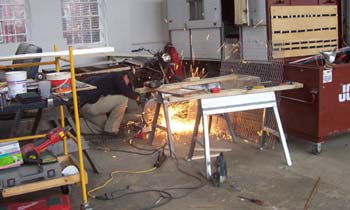By MICAH J. MALONE
I’m going to be sick to my stomach. Christoph Büchel and Mass MoCA are still at it, with no ideal or agreeable solution in sight. As it stands at this moment, the museum will continue with “Made at Mass MoCA”, a “documentary” that shows the remains of Büchel's unfinished project with covered tarps over large objects Büchel either brought in or had built. I have not seen the exhibition, nor do I care too, as the dilemma of the project itself is compelling and wrenching enough.
With budgets originally set at $150,000 but eventually growing to well over $300,000, Mass MoCA eventually put a cap on spending or simply ran out of money, that is after delaying the original opening and performing additional rounds of fund-raising. Art world responses have varied from fed up artists who are frustrated that an artist could not “make it work” with such a large budget, to others who have sympathy for Mass MoCA and their continued role in being one of the only institutions who have gigantic space dedicated to dream projects. Peter Plagens simplifies the situation as being a “win/win” for Büchel who gets the spotlight and press, which is apparently always a good thing. Who is responsible or at fault is really a mute point, in my mind, simply because the documentation and posturing from both sides show nothing more than legal speak and venting ideological rants.
From where it stands, it seems clear and even understated to say that no one wins here. Mass MoCA’s impeccable reputation for initiating compelling large scale projects is damaged, Büchel’s reputation for completing ambitious shows and his relationships with future institutions is most certainly damaged as well. It makes me ask one important question: Is this how art should be made?
Büchel is mostly known for his large-scale environments with meticulous detail afforded to each element to make them believable as “real.” Tunnels, lowered ceilings and evidence of trauma fill his works and are often referred to as “rooms within rooms”, situated to make the museum or gallery “disappear.” In the case of Mass MoCA, it might be apt to say “instituion within an instituition”, as a cinema, a jet fuselage, a house and other giant structures were slated to define the interior of Building 5 in North Adams. Ideologically speaking, his work tries to find a way to satirize, or perhaps re-construct harsh political realities by showing them as subject to change and manipulation. However, in all of Büchel’s work, especially the proposed Mass MoCA project, there is also a pursuit of something so extravagantly political, as if it is a contest to show how "political" he really is. Jacques Ranciére recently remarked, that many artists seem to be caught in a race between “the power of the market and the power of its denunciation.” While Ranciere did not necessarily have Büchel in mind, the police logic of Büchel’s work certainly lends itself to such dilemmas.
At its most effective, Büchel’s work “emancipates” the spectator/viewer by making them active. Indeed, one cannot view a Büchel installation without climbing through small spaces or navigating hidden doorways. The question in regards to the Mass MoCA debacle might be: How economically does Büchel immerse the viewer and to what extent were his requests absurd? As a counterpoint, Thomas Hirshhorn makes similarly loaded spaces with materials bought cheap or free. His trashy and overbearing environments speak directly to a viewer being able to steer his/her own political position. Both artists are mapping similar territory but, perhaps, Hirshhorn presents a far more viable option simply because his ideology is affordable. How future projects develop is unclear from this episode, but lets hope this is only an episode and not a series.
All images are courtesy of the Mass MoCA website.




